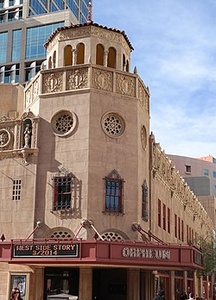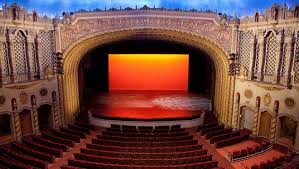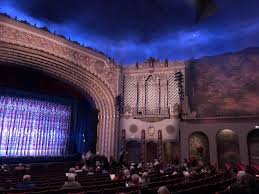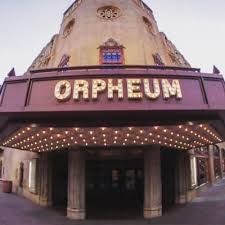Orpheum Theater
HISTORY OF THE ORPHEUM THEATER
The building of the Orpheum Theater began in 1927, until it was later officially opened on January 5th, 1929. Designed by Lescher & Mahoney, an architectural firm located in Phoenix, Arizona, the construction in total cost about $750,000. Upon opening, the theater was originally intended for vaudeville acts in accordance with the national Orpheum Circuit, a chain of both vaudeville and movie theaters spanning across the United States. These vaudeville acts featured many separate, unrelated performances that could range from acrobats and comedians to musicians and dancers. The theater itself though was built to be architecturally thoughtful, utilizing a Spanish Baroque architectural style, as well as murals and moldings so as to give the audience the feeling that they were experiences the shows “al fresco”. This feeling was induced by the atmospheric style of the theater, which featured murals of mountains, forests, and clouds over a domed blue-sky scenery. Later in the 1940’s, Paramount Pictures bought the Orpheum and changed its name to match, dubbing it “The Paramount”. Over these years, the theater featured many Hollywood stars including Henry Fonda, Mae West, and Lauren Bacall. Then, in the 1960’s, the theater was purchased by the Nederlander organization so as to feature it in their Broadway circuit, and was renamed “Palace West”. Moving through the 1970’s and 1980’s, the theater was leased to the local Mexican enterprising Corona family, who featured a wide variety of Hispanic movies and events.
RESTORATION
In the 1980’s the theater began falling into serious disrepair. Following this, in 1984 the city of Phoenix purchased the Orpheum, and began a 12-year restoration journey that would end up costing around $14.5 million to complete. The Conrad Schmitt Studios completed the restoration, and the Orpheum reopened once again in January of 1997. The restoration included extending the stage to a 47-foot depth, the fly extended to 66 feet, and an interior loading dock built under city hall continued to serve the theater. Furthermore, the lobby and box office were expanded, and the street in front of the theater was transformed into a plaza. Seating was reduced to 1,400 from its original 1,800, and handicap access was provided. The murals of the original theater were even reproduced, maintaining the al fresco style that was original to the Orpheum.
PRESENT DAY ORPHEUM
From its restoration until today, the Orpheum has undergone a series of changes and has added many different features to the show. In 1985, the theater was placed on the National Register of Historic Places, and in 1997 began housing the newly minted Phoenix Opera. The theater now presents a variety of shows, including concerts, Broadway musicals, certain special events including silent films accompanied by the Mighty Wurlitzer Theatre Organ, as well as performances of Ballet Arizona. Furthermore, through donations and contributions to the theater, a number of additions have been able to exist, such as a dance floor, green room furniture, children’s booster seats, assisted listening devices for the hearing impaired, closed-circuit TVs, a movie screen, and paint and furniture repairs.
ADMISSIONS/SURROUNDING AREA
Currently, due to the Covid-19 pandemic, showtimes at the Orpheum Theater have been delayed to all be featured in 2021. However, the theater would normally host a variety of shows, ticket prices varying depending on the performer. Featured there is an Afternoon at the Orpheum, historic tours, ghost tours, and Silent Sundays. There is also a free public tour of the theater that would normally run every Tuesday at 12 p.m. and 1 p.m. There is a good range or parking surrounding the Orpheum Theater, most including handicap aides as well. As far as food and drinks go, there is a small bar featured in the theater including snacks. Surrounding the theater are a variety of places to stop for food before or after a show, including sushi restaurants, an Irish pub, and multiple family owned restaurants.
IMPACTS ON THE COMMUNITY
Having been open for coming up on 92 years, the Orpheum Theater has spanned generations and has provided an abundance of entertainment for Phoenix residents and tourists alike. The theater is well loved, as seen by the hard-fought restoration efforts and continued support from the community. Friends of the Orpheum Theater is a website whose purpose is to “…further the legacy of the Orpheum Theatre by preserving its history and sharing its heritage with the community.” (https://www.fototphx.org) The website is an all-volunteer, non profit organization that exists to keep the legacy of the theater alive, a testament to its importance to the local community. The aforementioned tours of the Orpheum used to be hosted by the Friends of the Orpheum Theater, who managed the training and schedule of volunteer ushers for events and tours of the theatre until the activities were switched to the owners of the Orpheum, the Phoenix Convention Center and Venues. Furthermore, the Friends of the Orpheum Theater are entirely made up of volunteers in the community who love the theater and have made multiple very successful donation and membership drives for the theater itself. There are also a number of outreach programs that have been made surrounding the Orpheum, including Afternoon/Night at the Orpheum. This community program provides a night at the Orpheum to people unable to buy tickets due to financial instability, through tickets donated to community agencies who invite certain members of the community unable to buy tickets. The Friends of the Orpheum Theater also have multiple partners to further support the community, including:
- Free Arts for Abused Children of Arizona
- P.E.O International
- Combat Veterans Motorcycle Association
- Along Side Ministry
- Phoenix Symphony
- Walter Cronkite School of Journalism and Mass Communication
- Tetra String Quartet
- Spotlight Youth Theatre
The Orpheum also features a Local Artist Spotlight, which allows artists to submit their work online to the theater which will then be featured on the Orpheum website with a bio of the author. The artists work will then have the possibility to be published or used by the Orpheum.
REFERENCES:
https://www.azcentral.com/story/entertainment/arts/2014/08/06/orpheum-theatre-phoenix-fun-facts-trivia/13685077/
https://en.wikipedia.org/wiki/Orpheum_Theatre_(Phoenix,_Arizona)
https://www.fototphx.org/
http://www.orpheum-theater.com/orpheum_theater_phoenix.php
http://phoenixtheaterhistory.com/companies/orpheum-theatre/
https://phoenix.org/orpheum-theatre/
https://twitter.com/orpheumphx






